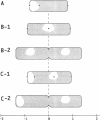Abstract
Plasmolysis bays, induced in Escherichia coli by hypertonic treatment, are flanked by zones of adhesion between the plasma membrane and the cell wall. To test the proposition of Cook et al. (W. R. Cook, F. Joseleau-Petit, T. J. MacAlister, and L. I. Rothfield, Proc. Natl. Acad. Sci. USA 84:7144-7148, 1987) that these zones, called periseptal annuli, play a role in determining the division site, we analyzed the positions of these zones by phase-contrast and electron microscopy. In situ treatment of cells grown in agar showed that the youngest cell pole was the most susceptible to plasmolysis, whereas the constriction site was resistant. Lateral bays occurred only at some distance from a polar bay or a resistant constriction site. Orienting cells with their most prominently plasmolyzed polar bay in one direction showed that the lateral bays were always displaced away from the polar bay at about half the distance to the other cell pole. If no poles were plasmolyzed, lateral bays occurred either in the centers of nonconstricting cells or at the 1/4 or 3/4 position of cell length in constricting cells. The asymmetric positions of lateral plasmolysis bays, caused by their abrupt displacement in the presence of polar bays or constriction sites, does not confirm the periseptal annulus model (Cook et al.), which predicts a gradual and symmetric change in the position of lateral bays with increasing cell length. Our analysis indicates that plasmolysis bays have no relation to the development and positioning of the future division site.
Full text
PDF






Images in this article
Selected References
These references are in PubMed. This may not be the complete list of references from this article.
- Cook W. R., Kepes F., Joseleau-Petit D., MacAlister T. J., Rothfield L. I. Proposed mechanism for generation and localization of new cell division sites during the division cycle of Escherichia coli. Proc Natl Acad Sci U S A. 1987 Oct;84(20):7144–7148. doi: 10.1073/pnas.84.20.7144. [DOI] [PMC free article] [PubMed] [Google Scholar]
- Cook W. R., MacAlister T. J., Rothfield L. I. Compartmentalization of the periplasmic space at division sites in gram-negative bacteria. J Bacteriol. 1986 Dec;168(3):1430–1438. doi: 10.1128/jb.168.3.1430-1438.1986. [DOI] [PMC free article] [PubMed] [Google Scholar]
- Cook W. R., Rothfield L. I. Biogenesis of cell division sites in ftsA and ftsZ filaments. Res Microbiol. 1991 Feb-Apr;142(2-3):321–324. doi: 10.1016/0923-2508(91)90047-e. [DOI] [PubMed] [Google Scholar]
- Cook W. R., de Boer P. A., Rothfield L. I. Differentiation of the bacterial cell division site. Int Rev Cytol. 1989;118:1–31. doi: 10.1016/s0074-7696(08)60871-2. [DOI] [PubMed] [Google Scholar]
- MacAlister T. J., Cook W. R., Weigand R., Rothfield L. I. Membrane-murein attachment at the leading edge of the division septum: a second membrane-murein structure associated with morphogenesis of the gram-negative bacterial division septum. J Bacteriol. 1987 Sep;169(9):3945–3951. doi: 10.1128/jb.169.9.3945-3951.1987. [DOI] [PMC free article] [PubMed] [Google Scholar]
- Macalister T. J., Macdonald B., Rothfield L. I. The periseptal annulus: An organelle associated with cell division in Gram-negative bacteria. Proc Natl Acad Sci U S A. 1983 Mar;80(5):1372–1376. doi: 10.1073/pnas.80.5.1372. [DOI] [PMC free article] [PubMed] [Google Scholar]
- Mulder E., Woldringh C. L. Actively replicating nucleoids influence positioning of division sites in Escherichia coli filaments forming cells lacking DNA. J Bacteriol. 1989 Aug;171(8):4303–4314. doi: 10.1128/jb.171.8.4303-4314.1989. [DOI] [PMC free article] [PubMed] [Google Scholar]
- Mulder E., Woldringh C. L. Autoradiographic analysis of diaminopimelic acid incorporation in filamentous cells of Escherichia coli: repression of peptidoglycan synthesis around the nucleoid. J Bacteriol. 1991 Aug;173(15):4751–4756. doi: 10.1128/jb.173.15.4751-4756.1991. [DOI] [PMC free article] [PubMed] [Google Scholar]
- Olijhoek A. J., Van Eden C. G., Trueba F. J., Pas E., Nanninga N. Plasmolysis during the division cycle of Escherichia coli. J Bacteriol. 1982 Oct;152(1):479–484. doi: 10.1128/jb.152.1.479-484.1982. [DOI] [PMC free article] [PubMed] [Google Scholar]
- Rothfield L. I., Cook W. R., de Boer P. A. Biogenesis of the Escherichia coli cell division system. Cold Spring Harb Symp Quant Biol. 1991;56:751–756. doi: 10.1101/sqb.1991.056.01.084. [DOI] [PubMed] [Google Scholar]
- Taschner P. E., Huls P. G., Pas E., Woldringh C. L. Division behavior and shape changes in isogenic ftsZ, ftsQ, ftsA, pbpB, and ftsE cell division mutants of Escherichia coli during temperature shift experiments. J Bacteriol. 1988 Apr;170(4):1533–1540. doi: 10.1128/jb.170.4.1533-1540.1988. [DOI] [PMC free article] [PubMed] [Google Scholar]
- Wientjes F. B., Nanninga N. Rate and topography of peptidoglycan synthesis during cell division in Escherichia coli: concept of a leading edge. J Bacteriol. 1989 Jun;171(6):3412–3419. doi: 10.1128/jb.171.6.3412-3419.1989. [DOI] [PMC free article] [PubMed] [Google Scholar]
- Woldringh C. L., Mulder E., Huls P. G., Vischer N. Toporegulation of bacterial division according to the nucleoid occlusion model. Res Microbiol. 1991 Feb-Apr;142(2-3):309–320. doi: 10.1016/0923-2508(91)90046-d. [DOI] [PubMed] [Google Scholar]
- Woldringh C. L., Mulder E., Valkenburg J. A., Wientjes F. B., Zaritsky A., Nanninga N. Role of the nucleoid in the toporegulation of division. Res Microbiol. 1990 Jan;141(1):39–49. doi: 10.1016/0923-2508(90)90096-9. [DOI] [PubMed] [Google Scholar]
- Woldringh C. L., de Jong M. A., van den Berg W., Koppes L. Morphological analysis of the division cycle of two Escherichia coli substrains during slow growth. J Bacteriol. 1977 Jul;131(1):270–279. doi: 10.1128/jb.131.1.270-279.1977. [DOI] [PMC free article] [PubMed] [Google Scholar]





